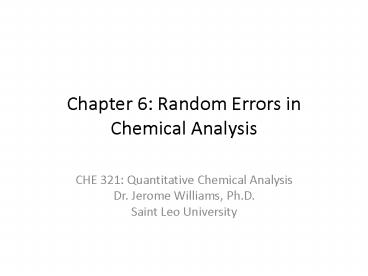Chapter 6: Random Errors in Chemical Analysis PowerPoint PPT Presentation
Title: Chapter 6: Random Errors in Chemical Analysis
1
Chapter 6 Random Errors in Chemical Analysis
- CHE 321 Quantitative Chemical Analysis
- Dr. Jerome Williams, Ph.D.
- Saint Leo University
2
Overview
- Calculating Standard Deviation in Excel
- Pooled Standard Deviation
- Propagation of Error Calculations
- Significant Figures
3
Calculating Standard Deviation in Excel
- Calculating sample statistics in Excel
- Standard deviation uses STDEV() function
- Variance uses VAR() function
- Coefficient of Variation, also called percent
relative standard deviation, is obtained by
taking the standard deviation divided by mean,
and that result is then multiplied by 100.
4
p.118
5
p.119
6
p.120
7
p.120
8
p.122
9
p.122
10
Pooled Standard Deviation
- Statistical testing (Chapter 7) based on sample
standard deviation. The better the s value, the
greater the probability of having correct
results. - As N increases (gt20), the sample standard
deviation value approaches that of the population
standard deviation. - If one has several subsets of data, a better
estimate of the population standard deviation is
obtained by pooling (combining) the data into one
global data set.
11
Statistical Treatment of Random Errors
- Pooled standard deviation (denoted by the letter
spooled) is a measure of the precision of a
sample data set and is calculated using the
following equation. - spooled SQRT (SUM (xi mean1)2 (xi mean2)2
/ N1 N2 - Nsubsets) - Note One degree freedom is lost for each data
subset.
12
Propagation of Error Calculations
- Sometimes one must estimate the standard
deviation of a result that has been calculated
from two or more experimental data points, each
having its own sample standard deviation.
13
Table 6-6 p110
14
Significant Figures
- Review the rules for counting significant figures
- Review the rules for determining significant
figures in calculations - Review the rounding convention in text
15
Figure 6-5 p116
16
Suggested Problems
- HW Set 5 6.2, 6.7, 6.8, 6.9 (a,c,e), 6.18
PowerShow.com is a leading presentation sharing website. It has millions of presentations already uploaded and available with 1,000s more being uploaded by its users every day. Whatever your area of interest, here you’ll be able to find and view presentations you’ll love and possibly download. And, best of all, it is completely free and easy to use.
You might even have a presentation you’d like to share with others. If so, just upload it to PowerShow.com. We’ll convert it to an HTML5 slideshow that includes all the media types you’ve already added: audio, video, music, pictures, animations and transition effects. Then you can share it with your target audience as well as PowerShow.com’s millions of monthly visitors. And, again, it’s all free.
About the Developers
PowerShow.com is brought to you by CrystalGraphics, the award-winning developer and market-leading publisher of rich-media enhancement products for presentations. Our product offerings include millions of PowerPoint templates, diagrams, animated 3D characters and more.

